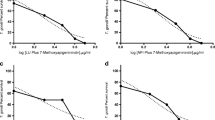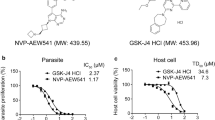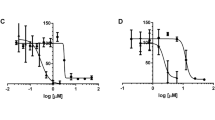Abstract
Purpose
Toxoplasmosis is caused by the parasite Toxoplasma gondii (T. gondii). In immunocompetent individuals, the infection is often asymptomatic; however, in expectant mothers and those with immune system deficiencies, complications may arise. Consequently, there is a need for new drugs that cause minimal damage to host cells. The purpose of this study was to investigate the in vitro antiparasitic efficacy of quinolone–coumarin hybrids QC1–QC12, derived from quinolone antibacterials and novobiocin, against T. gondii.
Methods
The derivatives were compared with novobiocin and ciprofloxacin during testing, with pyrimethamine used as a positive control. We conducted the MTT assay to examine the anti-toxoplasmic effects of the test compounds and novobiocin. Evaluation included the infection and proliferation indices, as well as the size and number of plaques, based on the viability of both healthy and infected cells.
Results
The in vitro assays revealed that QC1, QC3, QC6, and novobiocin, with selectivity indices (SIs) of 7.27, 13.43, and 8.23, respectively, had the least toxic effect on healthy cells and the highest effect on infected cells compared to pyrimethamine (SI = 3.05). Compared to pyrimethamine, QC1, QC3, QC6, and novobiocin Without having a significant effect on cell viability, demonstrated a significant effect on reducing in both infection index and proliferation index, in addition to reducing the quantity and dimensions of plaques ( P < 0.05).
Conclusion
Based on our results, QC1, QC3, QC6, and novobiocin due to their significant therapeutic effects could be considered as potential new leads in the development of novel anti-Toxoplasma agents.




Similar content being viewed by others
References
Chemoh W, Sawangjaroen N, Nissapatorn V, Suwanrath C, Chandeying V, Hortiwakul T et al (2013) Toxoplasma gondii infection: what is the real situation? Exp Parasitol 135(4):685–689. https://doi.org/10.1016/j.exppara.2013.10.001
Weiss LM (2013) Toxoplasma gondii: the Model Apicomplexan-perspectives and methods Ed, vol 2. Elsevier Science
Paniágua AL, Almeida RM, Leite FB, da Silva AC, Santos IJ, Moreira EE et al (2019) Toxoplasmosis in pregnant women: prevalence in one University Hospital (Brasília City, Distrito Federal, Brazil). Biomed J Sci Tech Res 15(3):1–2. https://doi.org/10.26717/BJSTR.2019.15.002698
Pappas G, Roussos N, Falagas ME (2009) Toxoplasmosis snapshots: global status of Toxoplasma gondii seroprevalence and implications for pregnancy and congenital toxoplasmosis. Int J Parasitol 39(12):1385–1394. https://doi.org/10.1016/j.ijpara.2009.04.003
Ajzenberg D, Lamaury I, Demar M, Vautrin C, Cabié A, Simon S et al (2016) Performance testing of PCR assay in blood samples for the diagnosis of toxoplasmic encephalitis in AIDS patients from the French departments of America and genetic diversity of Toxoplasma gondii: a prospective and multicentric study. PLoS Negl Trop Dis 10(6):e0004790. https://doi.org/10.1371/journal.pntd.0004790
Weiss LM (2013) Toxoplasma gondii: The Model Apicomplexan-Perspectives and Methods Ed. 2. Perspectives and methods
Martins-Duarte ES, Urbina JA, de Souza W, Vommaro RC (2006) Antiproliferative activities of two novel quinuclidine inhibitors against Toxoplasma gondii tachyzoites in vitro. J Antimicrob Chemother 58(1):59–65. https://doi.org/10.1093/jac/dkl180
Eyles D, Coleman N (1953) Synergistic effect of Sulfadiazlne and Daraprim against Experimental Toxoplasmosis in the mouse. Antibiot Chemother 3(5):483–490
Mcmaster PR, Powers KG, Finerty JF, Lunde MN (1973) The effect of two chlorinated lincomycin analogues against acute toxoplasmosis in mice. Am J Trop Med Hyg 22(1):14–17. https://doi.org/10.4269/ajtmh.1973.22.14
Dannemann B, McCutchan JA, Israelski D, Antoniskis D, Leport C, Luft B et al (1992) Treatment of toxoplasmic encephalitis in patients with AIDS: a randomized trial comparing pyrimethamine plus clindamycin to pyrimethamine plus sulfadiazine. Ann Intern Med 116(1):33–43. https://doi.org/10.7326/0003-4819-116-1-33
Mets MB, Holfels E, Boyer KM, Swisher CN, Roizen N, Stein L et al (1997) Eye manifestations of congenital toxoplasmosis. Am J Ophthalmol 123(1):1–16. https://doi.org/10.1016/S0002-9394(14)70986-9
Georgiev SV (1994) Management of toxoplasmosis. Drugs 48:179–188. https://doi.org/10.2165/00003495-199448020-00005
Luft BJ, Remington JS (1992) Toxoplasmic encephalitis in AIDS. Clin Infect Dis 15(2):211–222. https://doi.org/10.1093/clinids/15.2.211
F. H (2008) Post-treatment assessment of acute Toxoplasma infection during pregnancy. J Obstet Gynaecol 28:593–595. https://doi.org/10.1080/01443610802344332
Del Cacho E, Gallego M, Pages M, Monteagudo L, Sánchez-Acedo C (2006) Effect of the quinolone coccidiostat decoquinate on the rearrangement of chromosomes of Eimeria tenella. Int J Parasitol 36(14):1515–1520. https://doi.org/10.1016/j.ijpara.2006.08.004
Gouvea LR, Martins DA, da Gama Jean Batista D, de Nazaré C, Soeiro M, Louro SR, Barbeira PJ et al (2013) Norfloxacin Zn (II)-based complexes: acid base ionization constant determination, DNA and albumin binding properties and the biological effect against Trypanosoma cruzi. Biometals 26:813–825. DOI https://doi.org/10.1007/s10534-013-9661-z
Hooper DC (2001) Mechanisms of action of antimicrobials: focus on fluoroquinolones. Clin Infect Dis 32(Supplement1):S9–S15. https://doi.org/10.1086/319370
Johannes CB, Ziyadeh N, Seeger JD, Tucker E, Reiter C, Faich G (2007) Incidence of allergic reactions associated with antibacterial use in a large, managed care organisation. Drug Saf 30:705–713. https://doi.org/10.2165/00002018-200730080-00007
Martins-Duarte ES, Dubar F, Lawton P, França da Silva C, Soeiro MdN C, De Souza W et al (2015) Ciprofloxacin derivatives affect parasite cell division and increase the survival of mice infected with Toxoplasma gondii. PLoS ONE 10(5):e0125705. https://doi.org/10.1371/journal.pone.0125705
Emami S, Foroumadi A, Faramarzi MA, Samadi N (2008) Synthesis and antibacterial activity of Quinolone-based compounds containing a Coumarin Moiety. Archiv Der Pharmazie: Int J Pharm Med Chem 341(1):42–48. https://doi.org/10.1002/ardp.200700090
Akins CK, Panicker SE, Cunningham CL (2005) Laboratory animals in research and teaching: Ethics, care, and methods: American Psychological Association. https://doi.org/10.1037/10830-000
Barbosa BF, Gomes AO, Ferro EAV, Napolitano DR, Mineo JR, Silva NM (2012) Enrofloxacin is able to control Toxoplasma gondii infection in both in vitro and in vivo experimental models. Vet Parasitol 187(1–2):44–52. https://doi.org/10.1016/j.vetpar.2011.12.039
Gozalbes R, Brun-Pascaud M, Garcia-Domenech R, Galvez J, Girard P-M, Doucet J-P et al (2000) Anti-Toxoplasma activities of 24 quinolones and fluoroquinolones in vitro: prediction of activity by molecular topology and virtual computational techniques. Antimicrob Agents Chemother 44(10):2771–2776. https://doi.org/10.1128/aac.44.10.2771-2776.2000
Sanfelice RA, da Silva SS, Bosqui LR, Miranda-Sapla MM, Barbosa BF, Silva RJ et al (2017) Pravastatin and simvastatin inhibit the adhesion, replication and proliferation of Toxoplasma gondii (RH strain) in HeLa cells. Acta Trop 167:208–215. https://doi.org/10.1016/j.actatropica.2016.12.006
Khan AA, Araujo FG, Brighty KE, Gootz TD, Remington JS (1999) Anti-Toxoplasma gondii activities and structure-activity relationships of novel fluoroquinolones related to trovafloxacin. Antimicrob Agents Chemother 43(7):1783–1787. https://doi.org/10.1128/aac.43.7.1783
Ebrahimzadeh MA, Taheri MM, Ahmadpour E, Montazeri M, Sarvi S, Akbari M et al (2017) Anti-Toxoplasma effects of methanol extracts of Feijoa sellowiana, quercus castaneifolia, and Allium paradoxum. J Pharmacopunct 20(3):220. https://doi.org/10.3831/KPI.2017.20.026
Strober W (1997) Trypan blue exclusion test of cell viability. Curr Protoc Immunol 21(1):A3B–A31. https://doi.org/10.1002/0471142735.ima03bs21
Montazeri M, Emami S, Asgarian-Omran H, Azizi S, Sharif M, Sarvi S et al (2019) In vitro and in vivo evaluation of kojic acid against Toxoplasma gondii in experimental models of acute toxoplasmosis. Exp Parasitol 200:7–12. https://doi.org/10.1016/j.exppara.2019.03.009
Meneceur P, Bouldouyre M-A, Aubert D, Villena I, Menotti J, Sauvage V et al (2008) In vitro susceptibility of various genotypic strains of Toxoplasma gondii to pyrimethamine, sulfadiazine, and atovaquone. Antimicrob Agents Chemother 52(4):1269–1277. https://doi.org/10.1128/aac.01203-07
Alday PH, Doggett JS (2017) Drugs in development for toxoplasmosis: advances, challenges, and current status. Drug design, development and therapy 273– 93. https://doi.org/10.2147/DDDT.S60973
Montazeri M, Sharif M, Sarvi S, Mehrzadi S, Ahmadpour E, Daryani A (2017) A systematic review of in vitro and in vivo activities of anti-Toxoplasma drugs and compounds (2006–2016). Front Microbiol 8:25. https://doi.org/10.3389/fmicb.2017.00025
Schmidt DR, Hogh B, Andersen O, Hansen SH, Dalhoff K, Petersen E (2006) Treatment of infants with congenital toxoplasmosis: tolerability and plasma concentrations of sulfadiazine and pyrimethamine. Eur J Pediatr 165:19–25. https://doi.org/10.1007/s00431-005-1665-4
Dantas-Leite L, Urbina JA, de Souza W, Vommaro RC (2004) Selective anti-Toxoplasma gondii activities of azasterols. Int J Antimicrob Agents 23(6):620–626. https://doi.org/10.1016/j.ijantimicag.2003.11.005
Martins-Duarte ÉS, Lemgruber L, Lorente SO, Gros L, Magaraci F, Gilbert IH et al (2011) Evaluation of three novel azasterols against Toxoplasma gondii. Vet Parasitol 177(1–2):157–161. https://doi.org/10.1016/j.vetpar.2010.11.034
Collin F, Karkare S, Maxwell A (2011) Exploiting bacterial DNA gyrase as a drug target: current state and perspectives. Appl Microbiol Biotechnol 92:479–497. https://doi.org/10.1007/s00253-011-3557-z
Lin T-Y, NS, Gardiner Heddle J (2015) Functional analyses of the Toxoplasma gondii DNA gyrase holoenzyme: a janus topoisomerase with supercoiling and decatenation abilities. Sci Rep 5:1–13
Secrieru A, Costa IC, O’Neill PM, Cristiano ML (2020) Antimalarial agents as therapeutic tools against toxoplasmosis—a short bridge between two distant illnesses. Molecules 25(7):1574. https://doi.org/10.3390/molecules25071574
Rohini K, Srikumar P (2014) Therapeutic role of coumarins and coumarin-related compounds. J Thermodyn Catal 5(2):1–3
Mandlik V, Patil S, Bopanna R, Basu S, Singh S (2016) Biological activity of coumarin derivatives as anti-leishmanial agents. PLoS ONE 11(10):e0164585. https://doi.org/10.1371/journal.pone.0164585
de Souza JO, Almeida SM, Souza GE, Zanini CL, da Silva EM, Calit J et al (2021) Parasitological profiling shows 4 (1H)-quinolone derivatives as new lead candidates for malaria. Eur J Med Chem Rep 3:100012. https://doi.org/10.1016/j.ejmcr.2021.100012
Pate P, Wolfson J, McHugh G, Pan S, Swartz M (1986) Novobiocin antagonism of amastigotes of Trypanosoma cruzi growing in cell-free medium. Antimicrob Agents Chemother 29(3):426–431. https://doi.org/10.1128/aac.29.3.426
da Silva RJGA, Franco PS, Pereira AS, Milian IC, Ribeiro M et al (2017) Enrofloxacin and toltrazuril are able to reduce Toxoplasma gondii growth in human BeWo trophoblastic cells and villous explants from human third trimester pregnancy. Front Cell Infect Microbiol 7:340. https://doi.org/10.3389/fcimb.2017.00340
Acknowledgements
Hereby, the authors of the current study express their appreciation for the financial assistance they received from the Mazandaran University of Medical Sciences in Sari, Iran. The Mazandaran University of Medical Sciences Student Research Committee is gratefully acknowledged by the authors.
Funding
This research received no specific grant from any funding agency, commercial or not-for-profit sectors.
Author information
Authors and Affiliations
Contributions
The research’s design involved SHS, SE, and AD. The experiments were carried out by MS, MM, and ShSh. Data was examined by Akh. The essay was written by MS, ZHN, SAH and MP. The manuscript was heavily corrected by SE and SHS. All authors read and an approved the final manuscript.
Corresponding author
Ethics declarations
Competing Interest
The authors declare no conflict of interest.
Additional information
Publisher’s Note
Springer Nature remains neutral with regard to jurisdictional claims in published maps and institutional affiliations.
Rights and permissions
Springer Nature or its licensor (e.g. a society or other partner) holds exclusive rights to this article under a publishing agreement with the author(s) or other rightsholder(s); author self-archiving of the accepted manuscript version of this article is solely governed by the terms of such publishing agreement and applicable law.
About this article
Cite this article
Emami, S., Sadeghi, M., Shahdin, S. et al. In Vitro Evaluation of Anti-Parasitic Activities of Quinolone-Coumarin Hybrids Derived from Fluoroquinolones and Novobiocin Against Toxoplasma gondii. Acta Parasit. (2024). https://doi.org/10.1007/s11686-024-00852-9
Received:
Accepted:
Published:
DOI: https://doi.org/10.1007/s11686-024-00852-9




